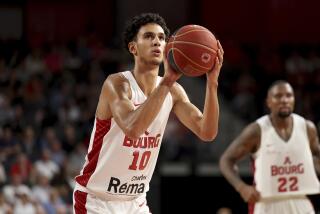Running Backs Rule, With Few Exceptions
Tips, advice and insight from our fantasy football expert.
• Team Previews | NFL Weekly Roundup
• Transactions | Injuries
• Preseason Schedule | Regular Season
• Times' NFL Coverage
Once upon a time, there was the Marshall (Faulk) Plan. Today, the L.T. Strategy would be a more appropriate name. Whatever you call it, the philosophy is the same: You can never go wrong drafting running backs with your first two picks.
Well, that’s not entirely true. If you ignored my advice and took Kevan Barlow in Round 2 last year, you went wrong. And if you insist on taking Chris Brown too early this year, you’ll be making a similar mistake.
But the general rule holds: Using the first two rounds to stock up on top-tier backs is the most foolproof method of building a winning fantasy team. The reasons are as simple as they are undeniable.
Top-notch running backs are in short supply, and the gulf between the elites and the second tier is as wide as J Lo’s backside. Wider still is the value differential between the second and third tiers. On the other hand, the gap between the best quarterbacks and rest of the field is not nearly as significant, and even less so for the wide receiver category.
What’s more, because the supply of top running backs is typically depleted by the end of Round 2, you’re stuck if you didn’t draft properly in the early rounds. Excellent quarterbacks and receivers will be plentiful in Rounds 3-5 and beyond. The opportunity cost of passing over an elite runner for a quarterback or receiver, therefore, is substantial, and difficult to overcome. Despite getting a top player at the position, you may be playing catch-up for the rest of the season, and that’s no fun at all. Just ask a 49er fan.
Let’s take a closer look at the handful of truly elite running backs — the rushers that are as reliable as they are explosive. This year, just seven backs fall in this category (listed below). It is imperative that you secure one of them with your first pick, if possible. They will be the foundation of your team, keeping you in every game throughout the season.
Elite backs, in order of value:
1. LaDainian Tomlinson, Chargers
2. Priest Holmes, Chiefs
3. Shawn Alexander, Seahawks
4. Edgerrin James, Colts
5. Deuce McAllister, Saints
6. Jamal Lewis, Ravens
7. Corey Dillon, Patriots
Following this initial group of sure-fire stars is a wave of second-tier RBs that are nearly as vital to your success. These are the backs that have the potential, though not the same probability, of notching outstanding fantasy statistics.
Some — such as Willis McGahee, Kevin Jones and Julius Jones — showed enough promise in their first year as starters to warrant high consideration. And at least one will likely join the elites this year.
Also in the second tier are some oldies but goodies, such as Ahman Green, Tiki Barber and Clinton Portis. They’ve been among the elite in recent years, but question marks surrounding their age, durability and/or offenses make them something of a gamble.
Second-tier backs, in order of value:
8. Ahman Green, Packers
9. Willis McGahee, Bills
10. Tiki Barber, Giants
11. Rudi Johnson, Bengals
12. Julius Jones, Cowboys
13. Kevin Jones, Lions
14. Domanick Davis, Texans
15. Clinton Portis, Redskins
Below this tier comes another group of backs that can help your team, but likely won’t lead it to a championship. One exception could be Michael Bennett, provided he kicks the injury bug that has made him such an underachiever in recent years. Like Bennett, the next tier of rushers has more significant risk associated with them — whether they be rookies, injury-prone or a member of the Over-the-Hill Gang. They should still be drafted high because several will be important cogs on your team, but you can afford to wait until the third or fourth round to claim your favorite.
But every rule has its exceptions, and with the L.T. Plan, the rule-breaker is named Manning. Peyton is the only non-RB who merits a first-round pick, though not nearly as high as many pundits recommend. He bridges the gap between the first- and second-tier backs. If you’re picking at the tail end of the first round, and the elites are off the board, go with Manning if he’s available and pick up the best second-tier back in Round 2.
In the second round, there are just two non-running backs that merit serious consideration: Randy Moss and Daunte Culpepper. Moss will likely go late in the first round, but that’s too high. You’re better off taking a second-tier back at that spot. But if he slides to the middle of Round 2, he’s worth grabbing.
Culpepper has been slipping to the late second round in many mock drafts, and that’s a great place to take him — assuming the second-tier backs have all been plucked. Remember, in many scoring formats last year, he was more valuable than Manning. Though he doesn’t have Moss to fling it to any more, Culpepper is still neck-and-neck with Peyton, and is a much better value as a second-rounder.
Terrell Owens has the potential to merit a second-round pick, but his recent antics make him too hot to handle that early in the draft. Call me crazy, but I prefer that my top receiver actually be on speaking terms with his quarterback.
The moral of the story is clear: Always take an elite back first, if you can. Follow him up with a great second-tier back, and begin building your receiving corps in Rounds 3 and 4, noting the above exceptions. A quarterback in Round 5, such as Trent Green or Marc Bulger, will do you just fine.
More to Read
Go beyond the scoreboard
Get the latest on L.A.'s teams in the daily Sports Report newsletter.
You may occasionally receive promotional content from the Los Angeles Times.










